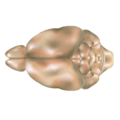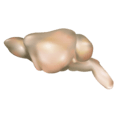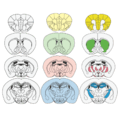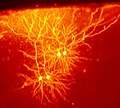Mouse brain
The mouse brain refers to the brain of Mus musculus. Various brain atlases exist.

For reasons of reproducability, genetically characterized, stable strains like C57BL/6 were chosen to produce high-resolution images and databases.[1] Well known online resources include:
- Allen Brain Atlas[2]
- Mouse Brain Library[3]
- High resolution mouse brain atlas
- BrainMaps
Despite superficial differences, especially in size and weight, the mouse brain and its function can serve as a powerful animal model for study of human brain diseases or mental disorders (see e.g. Reeler, Chakragati mouse). This is because the genes responsible for building and operating both mouse and human brain are 90% identical.[4]
Anatomy
The cerebral cortex of a mouse has around 8-14 million neurons while in those humans there are more than 10-15 billion.[5][6] The olfactory bulb volume takes about 2% of the mouse brain by volume in contrast to about 0.01% of the human brain.[7][8]
 Mouse brain, dorsal view
Mouse brain, dorsal view Mouse brain, lateral view
Mouse brain, lateral view Mouse brain slices
Mouse brain slices Mouse cingulate cortex neurons
Mouse cingulate cortex neurons
Development
- Mouse brain development timeline
See also
- List of animals by number of neurons
References
- MacKenzie-Graham, Allan; Jones, Eagle S.; Shattuck, David W.; Dinov, Ivo D.; Bota, Mihail; Toga, Arthur W. (2003). "The Informatics of a C57BL/6J Mouse Brain Atlas". Neuroinformatics. Springer Nature. 1 (4): 397–410. doi:10.1385/ni:1:4:397. ISSN 1539-2791. PMID 15043223.
- "ISH Data :: Allen Brain Atlas: Mouse Brain". ISH Data. Retrieved 2019-02-07.
- "Search the library". The Mouse Brain Library. 2003-06-05. Retrieved 2019-02-07.
- http://content.time.com/time/magazine/article/0,9171,1580427,00.html
- "Brain size and intelligence- why a human is smarter than a mouse". DNALC Blogs «. 2012-11-13. Retrieved 2019-02-07.
- Herculano-Houzel, Suzana; Catania, Kenneth; Manger, Paul R.; Kaas, Jon H. (2015). "Mammalian Brains Are Made of These: A Dataset of the Numbers and Densities of Neuronal and Nonneuronal Cells in the Brain of Glires, Primates, Scandentia, Eulipotyphlans, Afrotherians and Artiodactyls, and Their Relationship with Body Mass". Brain, Behavior and Evolution. S. Karger AG. 86 (3–4): 145–163. doi:10.1159/000437413. ISSN 0006-8977.
- McGann, John P. (2017-05-11). "Poor human olfaction is a 19th-century myth". Science. American Association for the Advancement of Science (AAAS). 356 (6338): eaam7263. doi:10.1126/science.aam7263. ISSN 0036-8075. PMC 5512720.
- "Brain Facts and Figures". faculty.washington.edu. Retrieved 2019-02-07.